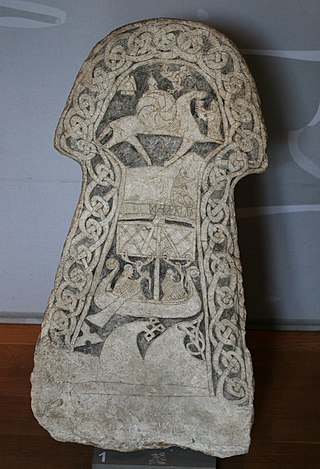
In Norse mythology, a valkyrie is one of a host of female figures who guide souls of the dead to the god Odin's hall Valhalla. There, the deceased warriors become einherjar. When the einherjar are not preparing for the cataclysmic events of Ragnarök, the valkyries bear them mead. Valkyries also appear as lovers of heroes and other mortals, where they are sometimes described as the daughters of royalty, sometimes accompanied by ravens and sometimes connected to swans or horses.
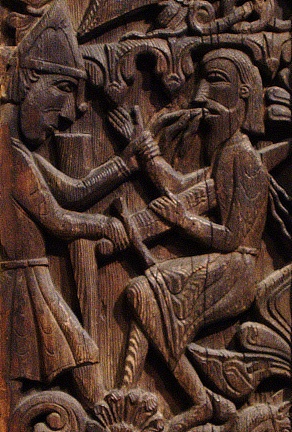
In Norse mythology, Reginn is a son of Hreiðmarr and the foster father of Sigurð. His brothers are Fáfnir and Ótr.

The Battle of Clontarf took place on 23 April 1014 at Clontarf, near Dublin, on the east coast of Ireland. It pitted an army led by Brian Boru, High King of Ireland, against a Norse-Irish alliance comprising the forces of Sigtrygg Silkbeard, King of Dublin; Máel Mórda mac Murchada, King of Leinster; and a Viking army from abroad led by Sigurd of Orkney and Brodir of Mann. It lasted from sunrise to sunset, and ended in a rout of the Viking and Leinster armies.

Thurso is a town and former burgh on the north coast of the Highland council area of Scotland. Situated in the historical County of Caithness, it is the northernmost town on the island of Great Britain. From a latitudinal standpoint, Thurso is located further north than the southernmost point of Norway and in addition lies more than 500 miles (800 km) north of London.

Caithness is a historic county, registration county and lieutenancy area of Scotland.

Earl of Orkney, historically Jarl of Orkney, is a title of nobility encompassing the archipelagoes of Orkney and Shetland, which comprise the Northern Isles of Scotland. Originally founded by Norse invaders, the status of the rulers of the Northern Isles as Norwegian vassals was formalised in 1195. Although the Old Norse term jarl is etymologically related to "earl", and the jarls were succeeded by earls in the late 15th century, a Norwegian jarl is not the same thing. In the Norse context the distinction between jarls and kings did not become significant until the late 11th century and the early jarls would therefore have had considerable independence of action until that time. The position of Jarl of Orkney was eventually the most senior rank in medieval Norway except for the king himself.

Sigurd Snake-in-the-eye or Sigurd Ragnarsson was a semi-legendary Viking warrior and Danish king active from the mid to late 9th century. According to multiple saga sources and Scandinavian histories from the 12th century and later, he is one of the sons of the legendary Viking Ragnar Lodbrok and Áslaug. His historical prototype might have been the Danish King Sigfred who ruled briefly in the 870s. Norwegian kings' genealogies of the Middle Ages name him as an ancestor of Harald Fairhair and used his mother's supposed ancestry to Völsung in order to create an ancestry between Harald and his descendants and Odin.
Thorfinn Torf-Einarsson also known as Thorfinn Skull-splitter was a 10th-century Earl of Orkney. He appears in the Orkneyinga saga and briefly in St Olaf's Saga, as incorporated into the Heimskringla. These stories were first written down in Iceland in the early 13th century and much of the information they contain is "hard to corroborate".
Darraðarljóð is a skaldic poem in Old Norse found in chapter 157 of Njáls saga. It consists of 11 stanzas recounting the vision of a man named Dörruð, in which twelve valkyries weave and choose who is to be slain at the Battle of Clontarf. Their loom uses human entrails as warp and woof, swords as treadles, an arrow as the batten and men's heads as weights. Of the twelve valkyries weaving, six of their names are given: Hildr, Hjörþrimul, Sanngriðr, Svipul, Guðr, and Göndul. Stanza 9 of the song has been translated:

The Earldom of Orkney was a Norse territory ruled by the earls of Orkney from the ninth century until 1472. It was founded during the Viking Age by Viking raiders and settlers from Scandinavia. In the ninth and tenth centuries it covered the Northern Isles (Norðreyjar) of Orkney and Shetland, as well as Caithness and Sutherland on the mainland. It was a dependent territory of the Kingdom of Norway until 1472, when it was absorbed into the Kingdom of Scotland. Originally, the title of Jarl or Earl of Orkney was heritable.
Sigurd Hlodvirsson, popularly known as Sigurd the Stout from the Old Norse Sigurðr digri, was an Earl of Orkney. The main sources for his life are the Norse Sagas, which were first written down some two centuries or more after his death. These engaging stories must therefore be treated with caution rather than as reliable historical documents.
Bróðir and Óspak of Man were two Danish or Norwegian brothers who were active in the Isle of Man and Ireland in the 11th century. They are mentioned in the 12th century Irish Cogadh Gaedhil re Gallaibh and the 13th century Icelandic Njal's Saga as the key leaders who fought on opposite sides in the Battle of Clontarf, in 1014. The latter account names Bróðir as the killer of Brian Boru, the High King of Ireland. Both Boru and Bróðir died in the battle, although accounts differ as to who killed whom. Óspak fought on the side of Boru, was injured, and lost his two sons in the battle.
Sigtrygg II Silkbeard Olafsson was a Hiberno-Norse king of Dublin of the Uí Ímair dynasty. He was caught up in the abortive Leinster revolt of 999–1000, after which he was forced to submit to the King of Munster, Brian Boru. His family also conducted a double marriage alliance with Boru, although he later realigned himself with the main leaders of the Leinster revolt of 1012–1014. He has a prominent role in the 12th-century Irish Cogadh Gaedhil re Gallaibh and the 13th-century Icelandic Njal's Saga, as the main Norse leader at the Battle of Clontarf in 1014.

Clan Sinclair is a Highland Scottish clan which holds the lands of Caithness, the Orkney Islands, and the Lothians. The chiefs of the clan were the Barons of Roslin and later the Earls of Orkney and Earls of Caithness.
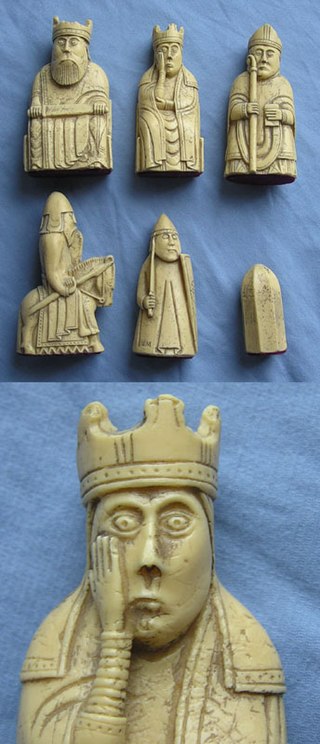
Harald Maddadsson was Earl of Orkney and Mormaer of Caithness from 1139 until 1206. He was the son of Matad, Mormaer of Atholl, and Margaret, daughter of Earl Haakon Paulsson of Orkney. Of mixed Norse and Gaelic blood, and a descendant of Scots kings, he was a significant figure in northern Scotland, and played a prominent part in Scottish politics of the twelfth century. The Orkneyinga Saga names him one of the three most powerful Earls of Orkney along with Sigurd Eysteinsson and Thorfinn Sigurdsson.
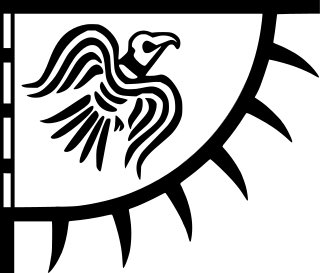
The Mormaer of Caithness was a vassal title mostly held by members of the Norwegian nobility based in Orkney from the Viking Age until 1350. The mormaerdom was held as fief of Scotland and the title was frequently held by the Norse Earls of Orkney, who were thus a vassal of both the King of Norway and the King of Scots. There is no other example in the history of either Norway or of Scotland in which a dynasty of earls owed their allegiance to two different kings.

The raven banner was a flag, possibly totemic in nature, flown by various Viking chieftains and other Scandinavian rulers during the 9th, 10th and 11th centuries. Period description simply describes it as a war banner with a raven mark on it, although no complete visual description or depiction of the raven banner is known from the time. Norse and European period artwork, however, depicts war banners as roughly triangular, with a rounded outside edge on which there hung a series of tabs or tassels, some with a resemblance to ornately carved "weather-vanes" used aboard Viking longships, indicating that some raven banners may have been constructed in a similar manner.
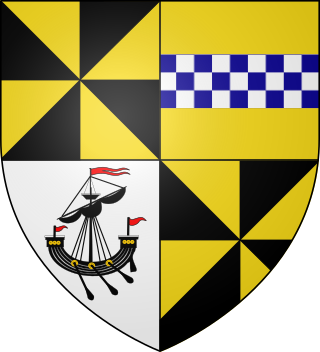
The Battle of Altimarlach was a Scottish clan battle that took place on 13 July 1680, near Wick, Caithness, Scotland. It was fought in a dispute between Sir John Campbell of Glenorchy and George Sinclair of Keiss over who had the right to the title and lands of the Earl of Caithness. The battle was fought between men of the Clan Campbell and Clan Sinclair. Campbell of Glenorchy won a decisive victory in the battle, but Sinclair of Keiss later turned to the law and was awarded the title of Earl of Caithness.

The Battle of Summerdale was fought on 19 May 1529, and was the last battle to take place on Orkney soil. The battle took place on the boundary of the parishes of Orphir and Stenness in Mainland, Orkney. The battle was fought between the Sinclairs of Orkney and Shetland and the Sinclairs of Caithness, who had the support of James V, King of Scotland.
Lachlan Mor Mackintosh, 16th of Mackintosh was the chief of the Clan Mackintosh, a Scottish clan of the Scottish Highlands. He was also chief of the confederation of clans that was known as the Clan Chattan.












